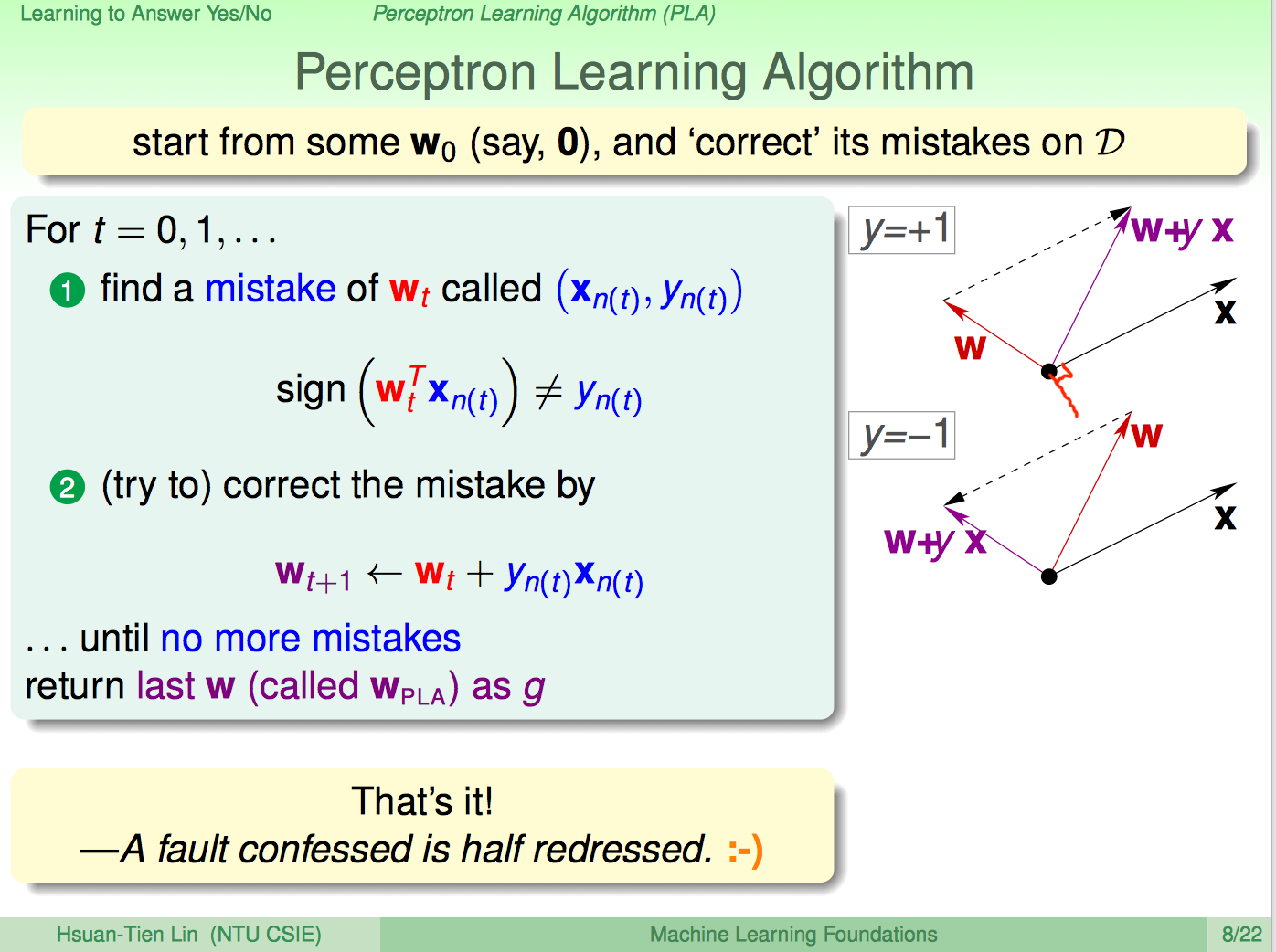02 Learning to Answer Yes/No
从最简单最基础的二分类问题出发,演示一个简单机器学习算法PLA的完整过程,见详细课件。
回顾
The Learning Problem:
$A$ takes $D$ and $H$ to get $g$ that approximate target function $f$.
这节课foucus在Hypothesis Set,用Perceptron(linear binary classifiers)演示如何解决二分类问题。如根据用户age/salary/等特征判定是否发放信用卡。
PLA算法
算法形式极其简洁,权重x特征,大于零正例;小于零负例。
算法迭代步骤,关键点是有错才改:
- 初始化$\textbf w_0 = \textbf 0$
- 找一个误分类点$y_n \textbf w_t^T \textbf x_n < 0$
- 更新权重$\textbf w_{t+1} = \textbf w_t + y_n\textbf x_n$
- 直到没有误分类点,返回$\textbf w$
最重要的是当发现误分类点时,更新权重:
Intuition

最直观的Intutiton,每一步更新如何使结果更好?
- $y = +1$: 误分则$\textbf w$和$\textbf x$夹角大于90度,更新$\textbf w$后使其往$\textbf x$靠近,夹角变小
- $y = -1$: 误分则$\textbf w$和$\textbf x$夹角小于90度,更新$\textbf w$后使其离$\textbf x$更远,夹角变大
收敛性证明
PLA算法有前提是数据集线性可分。
线性可分: Exists perfect $\textbf w_f$ such that $y_n=sign(\textbf w_f^T\textbf x_n)$
如果数据集线性可分,能保证算法收敛吗?如何证明?思路是
- 假设目标$\textbf w_f$完美分开数据集
- 证明每一轮$\textbf w_f^T \textbf w_t$至少线性增加
- 证明每一轮$\textbf w_t$长度无法达到线性增加
- 其夹角会递减,有限迭代后,$\textbf w_t$会收敛到$\textbf w_f$
Inner product of $\textbf w_f$ and $\textbf w_t$ grows fast; length of $\textbf w_f$ grows slowly. PLA ‘lines’ are more and more aligned with $\textbf w_f$ then halts.
因为$\textbf w_f$将每个数据都正确分类,所以:
利用归纳法容易得到:
证明每次迭代,其內积至少是线性增长。內积大一定程度上反映两个向量夹角更接近,当然还需要考虑其长度。
考虑向量长度:
其中:
可以看到,向量长度增加速度为$\sqrt t$,达不到线性。且$\textbf w_f$长度固定,综合上面两个结论:
最后推论出$t$存在上界:
PLA改进
PLA只能处理线性可分数据集,Pocket PLA稍微改进:
If $\textbf w_{t+1}$ makes fewer mistakes than $\textbf w_{t}$, replace $\textbf w_{t+1}$ by $\textbf w_{t+1}$.
数据集不可分情况下也能保证找到较优的解。
